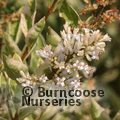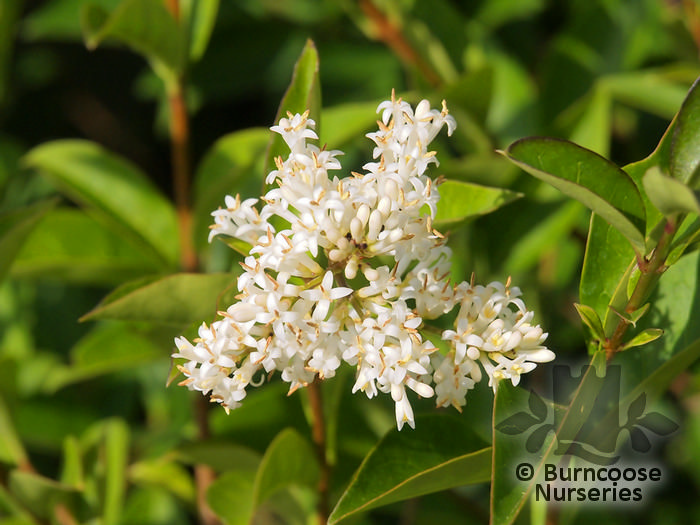Plants by mail order since 1984, over 4100 plants online today
Nursery & Gardens open: Mon - Sat 8:30 - 17:00 & Sun 10:00 - 16:00
Pop up café: open weather dependent
- Shop Now
- Burncoose Specialities
- This Month
- Offers & Promotions
- RHS Chelsea Flower Show 2024
- 40 years at Burncoose
- Engage With Us
- Information, Help & Advice
- About Us & Our Services
- Terms & Conditions
- Log In / Register
LIGUSTRUM ovalifolium
Commonly known as Oval-leaf privet
Common green privet
Further Reading....
-
EvergreenTo semi evergreen. Oval, rich-green leaves to 6cm (2½in) long.
-
 White
White -
 Height4m (13ft)
Height4m (13ft) -
 Spread4m (13ft)
Spread4m (13ft) -
HedgeIdeal for hedging
-
Tall ShrubVigorous, upright shrub. Flowers are followed by spherical, shiny black fruit.
-
 Hardy - cold winterHardy in most places throughout the UK even in severe winters. May not withstand open/exposed sites or central/northern locations. Plant can withstand temperatures down to -15°C (5°F)
Hardy - cold winterHardy in most places throughout the UK even in severe winters. May not withstand open/exposed sites or central/northern locations. Plant can withstand temperatures down to -15°C (5°F) -
 Full sun
Full sun -
 Partial shade
Partial shade
LIGUSTRUM ovalifolium
-
Additional Features
 Good to knowThe privet most usually seen, but from Japan. Useful for hedging. More reliably evergreen than our native but offers little to wildlife.
Good to knowThe privet most usually seen, but from Japan. Useful for hedging. More reliably evergreen than our native but offers little to wildlife. Pests & DiseasesAphids, scale, leaf miners, thrips, leaf spot, honey fungus, wilt.
Pests & DiseasesAphids, scale, leaf miners, thrips, leaf spot, honey fungus, wilt. Place of originJapan
Place of originJapan -
Flower ShapePaniclesDense panicles to 10cm (4in) long
-
Garden Location/ConditionsBorderSuitable for a shrub border
-
HardinessFully hardy
-
Leaf margin
 Entire
Entire(see photos above) -
Pruning group
 Pruning group 1Suitable for: Deciduous and evergreen trees, and some deciduous shrubs.
Pruning group 1Suitable for: Deciduous and evergreen trees, and some deciduous shrubs.
Pruning: Minimal pruning required. Prune wayward or crossing branches to maintain a healthy framework.
When: When dormant in the late winter/early spring. Some in the summer/autumn to prevent bleeding of sap.
-
Seasonal InterestSummer
-
Soil ConditionsFertile well drained soil
-
Toxic - Category C
 Harmful if eatenPeople and pets, i.e. cats, dogs, rabbits, rodents
Harmful if eatenPeople and pets, i.e. cats, dogs, rabbits, rodents -
WildlifeRabbit Resistant
Jan
Feb
Mar
Apr
May
Jun
Jul
Aug
Sep
Oct
Nov
Dec
Cold weather damage to evergreen plants
Ligustrum - Growing Guide
|
4m (13ft)
|

|

|
|
4m (13ft) |
Buy Varieties of LIGUSTRUM ovalifolium

LIGUSTRUM ovalifolium 'Argenteum'
Silver privet
cream edged leaves


LIGUSTRUM ovalifolium 'Aureum'
Golden privet
golden variegated privet
Useful extras...

Fertilisers & Feeds - Vitax
Q4 Pelleted Fertiliser
A useful fertiliser suitable for use on a wide variety of plants. Q4 provides all the nutrients and trace elements essential for vigorous growth, abundant flowering and ripening of fruit.
3 options from £6.00

Fertilisers & Feeds - Empathy
Afterplant - Grow Your Own
AFTER PLANT GROW YOUR OWN seaweed is ready to use liquid concentrate that was specially formulated be used on all edible plants.
Only £8.00

Fertilisers & Feeds - Empathy
Afterplant - Tomatoes
AFTER PLANT TOMATO FEED Liquid Concentrate with Bio stimulant is a high potash liquid concentrate containing seaweed extract, plant derived amino acids and other nutrients specifically formulated to benefit tomatoes and greenhouse plants.
Only £8.00

Fertilisers & Feeds - Empathy
Rootgrow mycorrhizal fungi
Recommended by the RHS. Contains Rootgrow™ mycorrhizal fungi. Suitable for all trees and shrubs (except rhododendrons, azaleas, heathers, cranberries and blueberries)
3 options from £3.00

Fertilisers & Feeds - Empathy
Rootgrow Ericoid mycorrhizal fungi
This specially adapted Rootgrow™ mycorrhizal fungi will boost the growth of acid-loving plants like rhododendrons, azaleas, heathers and blueberries.
It contains ericoid and arbuscular mycorrhizal fungi, which are found in poor acidic soils where ericaceous plants naturally grow.
Only £7.50

Fertilisers & Feeds - Empathy
All-purpose Seaweed Stimulant
All-purpose organic concentrated seaweed feed that is a ready to use, derived from sustainable harvested kelp, that can be used on all outdoor and indoor plants, except acid loving plants.
Perfect used in conjunction with Rootgrow™.
Only £7.50













 Gift-wrapping available
Gift-wrapping available







